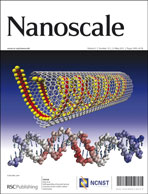Plasmonic organic photovoltaic devices with graphene based buffer layers for stability and efficiency enhancement
Abstract
Enhancement of photoconversion efficiency (PCE) and stability in bulk heterojunction (BHJ) plasmonic organic photovoltaic devices (OPVs) incorporating graphene oxide (GO) thin films as the hole transport layer (HTL) and


 Please wait while we load your content...
Please wait while we load your content...